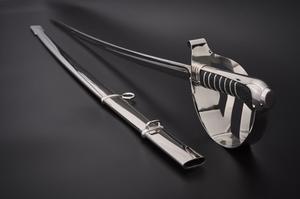Sabre - weapon and symbol of office
11. dubna 2023
Creating replicas of historic cold weapons is the part of manufacturing that we are truly proud of. There is some technical challenge on virtually every knife that makes it not so easy to make. However, there are many times more of these challenges on any faithful copy of a historical weapon, which includes the saber.
Sabres came to Europe from the East, where they were used in the early Middle Ages. This is shown by their single-edged, slightly curved blade. It is the curved blade that can be advantageous over straight weapons because, if handled correctly, it can be used effectively not only for chopping and cutting, but also for thrusting back.

The weapon was most widely used in the military in the 18th century, but by the 19th century it had also become a statement of status and function. Thus, in addition to soldiers, it was also carried by gendarmes, policemen, members of the fire brigade, and even civil servants, postal and railway employees and professors.
The wearing of sabres as a common accessory ceased after the Second World War and the sabre is now used as an accessory to the ceremonial uniforms of generals and parade troops. There is therefore no need to issue regulations similar to those that applied to gendarmes in the First Republic: 'When cycling, a sabre is not to be taken with you, except that the nature of the service in question recommends that you take a sabre with you. In this case, it shall be fixed in the handles on the fork of the front wheel."
If you like history and can appreciate precision craftsmanship, you can get a copy of the vz. 24/27 gendarme walking sabre for constables and chief constables, which was also covered by this regulation, can be ordered here. And if you prefer other historical cool weapons, you can also order a copy of cord of czechoslovak pilots, the sword of Czechoslovak custom officers in lion and, in the near future, in lioness.

